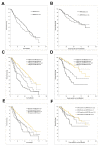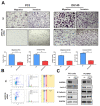ARPC1B Is Associated with Lethal Prostate Cancer and Its Inhibition Decreases Cell Invasion and Migration In Vitro
- PMID: 35163398
- PMCID: PMC8836051
- DOI: 10.3390/ijms23031476
ARPC1B Is Associated with Lethal Prostate Cancer and Its Inhibition Decreases Cell Invasion and Migration In Vitro
Abstract
ARPC1B (Actin Related Protein 2/3 Complex Subunit 1B) has been found to be involved in platelet abnormalities of immune-mediated inflammatory disease and eosinophilia. However, its role in prostate cancer (PCa) has not been established. We characterized the role of ARPC1B in PCa invasion and metastasis and investigated its prognosis using in vitro cellular models and PCa clinical data. Higher immunohistochemistry (IHC) expressions of ARPC1B were observed in localized and castrate resistant PCa (CRPC) vs. benign prostate tissue (p < 0.01). Additionally, 47% of patients with grade group 5 (GG) showed high ARPC1B expression vs. other GG patients. Assessing ARPC1B expression in association with two of the common genetic aberrations in PCa (ERG and PTEN) showed significant association to overall and cause-specific survival for combined assessment of ARPC1B and PTEN, and ARPC1B and ERG. Knockdown of ARPC1B impaired the migration and invasion of PC3 and DU145 PCa cells via downregulation of Aurora A kinase (AURKA) and resulted in the arrest of the cells in the G2/M checkpoint of the cell cycle. Additionally, higher ARPC1B expression was observed in stable PC3-ERG cells compared to normal PC3, supporting the association between ERG and ARPC1B. Our findings implicate the role of ARPC1B in PCa invasion and metastasis in association with ERG and further support its prognostic value as a biomarker in association with ERG and PTEN in identifying aggressive phenotypes of PCa cancer.
Keywords: ARPC1B; ERG; PTEN; immigration; invasion; prognosis; prostate cancer.
Conflict of interest statement
The authors declare no conflict of interest.
Figures






Similar articles
-
ING3 is associated with increased cell invasion and lethal outcome in ERG-negative prostate cancer patients.Tumour Biol. 2016 Jul;37(7):9731-8. doi: 10.1007/s13277-016-4802-y. Epub 2016 Jan 23. Tumour Biol. 2016. PMID: 26803516
-
P2X4 purinergic receptors offer a therapeutic target for aggressive prostate cancer.J Pathol. 2022 Feb;256(2):149-163. doi: 10.1002/path.5815. Epub 2021 Nov 25. J Pathol. 2022. PMID: 34652816 Free PMC article.
-
PTEN deletion and heme oxygenase-1 overexpression cooperate in prostate cancer progression and are associated with adverse clinical outcome.J Pathol. 2011 May;224(1):90-100. doi: 10.1002/path.2855. Epub 2011 Mar 7. J Pathol. 2011. PMID: 21381033
-
Characterizing the molecular features of ERG-positive tumors in primary and castration resistant prostate cancer.Prostate. 2016 Jun;76(9):810-22. doi: 10.1002/pros.23171. Epub 2016 Mar 16. Prostate. 2016. PMID: 26990456 Free PMC article.
-
The prognostic and predictive value of TMPRSS2-ERG gene fusion and ERG protein expression in prostate cancer biopsies.Dan Med J. 2016 Dec;63(12):B5319. Dan Med J. 2016. PMID: 27910803 Review.
Cited by
-
Comprehensive profiling of migratory primordial germ cells reveals niche-specific differences in non-canonical Wnt and Nodal-Lefty signaling in anterior vs posterior migrants.bioRxiv [Preprint]. 2025 Jun 2:2024.08.29.610420. doi: 10.1101/2024.08.29.610420. bioRxiv. 2025. PMID: 39257761 Free PMC article. Preprint.
-
High expression of ARPC1B correlates with immune infiltration and poor outcomes in glioblastoma.Biochem Biophys Rep. 2023 Dec 19;37:101619. doi: 10.1016/j.bbrep.2023.101619. eCollection 2024 Mar. Biochem Biophys Rep. 2023. PMID: 38188361 Free PMC article.
-
Development and validation of a prognostic prediction model for endometrial cancer based on CD8+ T cell infiltration-related genes.Medicine (Baltimore). 2024 Dec 6;103(49):e40820. doi: 10.1097/MD.0000000000040820. Medicine (Baltimore). 2024. PMID: 39654198 Free PMC article.
-
ARPC1B is a novel prognostic biomarker for kidney renal clear cell carcinoma and correlates with immune infiltration.Front Mol Biosci. 2023 Sep 19;10:1202524. doi: 10.3389/fmolb.2023.1202524. eCollection 2023. Front Mol Biosci. 2023. PMID: 37795220 Free PMC article.
-
Exploring heterogeneous expression of beta-actin (ACTB) in bladder cancer by producing a monoclonal antibody 6D6.BMC Urol. 2024 Jun 12;24(1):124. doi: 10.1186/s12894-024-01489-6. BMC Urol. 2024. PMID: 38867273 Free PMC article.
References
-
- Kumagai K., Nimura Y., Mizota A., Miyahara N., Aoki M., Furusawa Y., Takiguchi M., Yamamoto S., Seki N. Arpc1b gene is a candidate prediction marker for choroidal malignant melanomas sensitive to radiotherapy. Investig. Ophthalmol. Vis. Sci. 2006;47:2300–2304. doi: 10.1167/iovs.05-0810. - DOI - PubMed
MeSH terms
Substances
Grants and funding
LinkOut - more resources
Full Text Sources
Medical
Molecular Biology Databases
Research Materials
Miscellaneous

